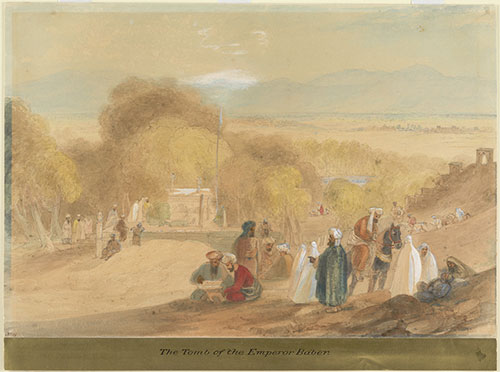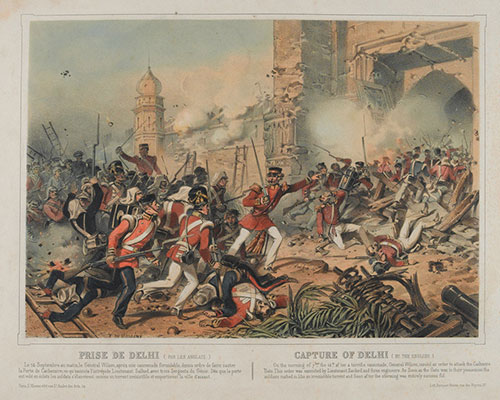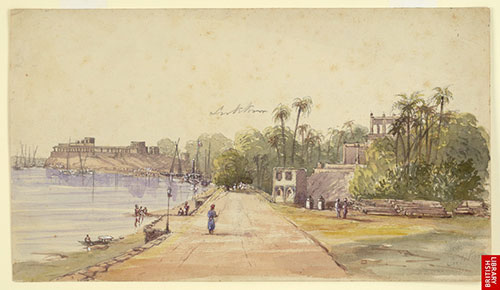Workshop on 'Doing History' in Pakistan

Near Kabul, Afghanistan (Source: British Library)
Mon, Mar 7: 11 AM-1 PM. Venue: G&T Auditorium, Main Campus.
Panel I - Knowledge and Identity in the Persianate Ecumene
Dr Moiz Hasan (IBA, Karachi), Islam, Science, and the Lesson of History: Al-Jurjani’s Defense of the Mathematical Sciences
The scientific achievements of scholars in pre-modern Islamicate societies are relatively well known. Less well known, though of comparable importance, are the philosophical foundations on which these stand. In this , I offer a brief exposition of aspects of these foundations and its significance (philosophical, historical, and historiographical) in the relatively understudied postclassical period, by focusing on the works of the eminent Ashʿarite polymath, Sayyid al-Sharif al-Jurjani (d. 816/1413). Jurjani’s vision of the mathematical sciences and its attendant philosophy reveal how many of his ideas draw, in varying degrees, from intellectual sources as diverse as theology (kalam), philosophy (falsafa), jurisprudence (usul al-fiqh), and Sufism (tasawwuf), the extent and nature of cross-fertilizations between these intellectual currents, and the manner in which Jurjani can combine different approaches to knowledge into a coherent epistemological scheme. Of significant philosophical import is the contribution Jurjani makes in resolving two, specific problems in the philosophy of science of his time: the status of mathematical entities, and that of astronomical models and their relation to reality. I argue that Jurjani’s solution lies in the specific manner he addresses epistemological issues concerning knowledge, truth, and reality, its distinctive feature being a turning away from the Avicennian theory of true knowledge based on the Active Intellect to a more economical, human-centered epistemology built on his novel understanding of the key concept of nafs al-amr (lit., the thing itself). Finally, equally significant is the historiographical import of Jurjani’s project for it provides further concrete evidence that cuts through many of the prevalent grand narratives that often discredit philosophical activity in the postclassical Islamic era or posit essentialist (often antagonistic) relation between Islam and science.
Zahra Sabri (IBA, Karachi), Delhi’s Mastery in Persian and Urdu: Amir Khusrau and Themes Relating to 'Standardised' Speech in Indo-Muslim Literary History
My presentation concerns a foreword that Amir Khusrau wrote to his third diwan of poetry Ghurrat ul-Kamal (Prime of Perfection). Written in 1294, this dibachah or foreword is considered to be an extremely important text with regard to Indo-Iranian poetics and Persian poetry in India. In it, Amir Khusrau argues vigorously to defend the high standards of Persian poetry in general and of the Persian language as used in India in particular, insisting that the Persian poets of India, and within India, Delhi most especially, should not be underestimated and in fact their mastery over this language outrivaled that of many other Iranian and Central Asian regions where Persian was current in his era. While analysing this claim of Khusrau’s in the context of Persian in India as compared to Persian in its original homeland of Iran, I take the opportunity to think about the relationship of Urdu in present-day Pakistan with Urdu in its original heartland of Delhi and in places like Hyderabad, Gujarat, and Bombay in modern-day India. Interesting parallels emerge between some of the views and attitudes that Khusrau held about Persian in India and those seen among ‘non-native’ speakers of Urdu in today’s Pakistan.
Dr Shayan Rajani (LUMS, Lahore), The Men in the Inscription: Rethinking the Individual in the Mughal World
After the conquest of Kandahar in 1522, Babur (r. 1526-30) built an arched grotto, the Forty Steps Monument, in the mountains nearby. Some seventy years later, a Mughal noble from Sindh, Mir Muhammad Masum dramatically intervened in the monument by adding an extensive inscription. In this paper, I argue that Masum’s actions indicate that a monument such as this was not considered a sacrosanct or inviolable expression of one individual. Rather, it was an open-ended invitation for others to participate in Babur’s legacy, while simultaneously leaving their own mark. In turn, this ethics of mutually beneficial participation explains how Mughal sovereignty attained its depth and breadth across the vast expanses of South and Central Asia.
Moderator: Dr Syed Jaffar Ahmed (IBA, Karachi)

Capture of Delhi, 1857 (Source: National Army Museum, London)
Mon, Mar 7: 2:30 PM-4:30 PM. Venue: G&T Auditorium, Main Campus.
Panel II - National Narratives and Local Histories
Dr Tahir Kamran (BNU, Lahore), Intellectual Currents in Regional History: A Case of Southeast Punjab
The vernacularisation of historical discourse calls for a distinct skillset to analyse discursive currents of (sub)regional histories. Oral genres comprising var, dastan, or epics like Hir Waris Shah or Saif ul-Muluk are a source for understanding historical currents that until recently existed at a subterranean level. Simply put, these are Peoples’ Histories with a bottom-up trajectory with respect to their methodology, multi-disciplinarity, and mode of narration. These histories have remained hidden from the state’s national/officially-sanctioned historical narrative based on 'facts' preserved in state-run archives. The Rankean method of according centrality to ‘objectivity’, with its unequivocal focus on the national narrative, which circulates in the academic circles, tends to exclude these histories. In this study, I have examined an instance whereby the arrival of a Sufi saint Pir Abd ur-Rahman on the southern fringe of the Jhang district has been preserved in collective memory. Purportedly one of the first Arab Muslims arriving in northern India (even before Muhammad bin Qasim's descended on Sindh in the eighth-century), Pir Abd ur-Rahman’s mausoleum is today situated on the Chenab riverbank, slightly away from the Garh Maharaja-Muzaffargarh road. Narrations of the event of Pir Abdul Rahman's arrival in this region defies a modern-rational mode of narration, as my paper will demonstrate.
Mohammad Nabeel Jafri (IBA, Karachi), ‘Envisioned by a Sunni, executed by a Shiʿa’: Histories of Pakistan in Urdu Shiʿi khitabat
In the ubiquitous ritual performance of Urdu Shiʿi khitabat (oratory), histories of Pakistan loom large. The title of my abstract captures one such representative claim where the referents Iqbal and Jinnah are reduced to one-dimensional religious identities in service of a linear, teleological historical narrative summarizing the origins of Pakistan. The claim is visibly inflected with the state-sponsored historical depiction of Iqbal as the founder-philosopher and Jinnah as the creator-leader of Pakistan. Yet, the claim does not simply parrot the state’s ideological envisioning: the claim, through its identification of differing religious affiliations of each figure, also presents its own normative conception of what Pakistan should aspire towards. My paper argues that semiotic attention to khitabat illustrates the crucial work that signifiers— here Iqbal and Jinnah but generally a constellation of persons, events, and ideas that emanate from a nationalist historiography— do within and beyond the context of Urdu Shiʿi oratory. Rather than engage in positivist historical arguments over the religious inclinations, or lack thereof, of Iqbal and Jinnah, I draw upon a plethora of ethnographic examples to highlight how myriad nationalist historiographical narratives live and proliferate in the imaginations and practices of Urdu-speaking Shiʿa in Pakistan. The simultaneous validation of, but also a challenge to, state-sponsored historical narratives marks one instance of how a minority population stakes its claim to the dominant discourses and practices of a given structure. I read against commonplace conceptions of Shiʿa (arguably, and more generally, minority) rhetoric and practice as ‘resistance’, ‘subversion’, and ‘assertion’, by demonstrating the centrality of minority religious performances in legitimating, disbursing, and reifying the majority state ideology. My arguments emerge from 20 months of ethnographic and archival fieldwork conducted in Karachi, Pakistan, for my doctoral research, in 2019, and 2020-2022.
Dr S. Akbar Zaidi (IBA, Karachi), Zillat: Nostalgia, Melancholy and Muslim Agency in Nineteenth Century North Indian Intellectual History
Much scholarship on Muslims in 19th century north India extensively uses the tropes of ‘traumatic shock’, ‘nostalgia’, ‘collective trauma’, ‘grief’, ‘collective mourning’, ‘lamentation’ ‘a deep psychological wound’, and similar themes to talk about Muslim emotions after the Indian Mutiny of 1857 which resulted in the end of Mughal rule and and the formal onset of British colonial rule. Instead of talking about the Muslim psychological reaction to the perceived loss of political power (in India and elsewhere in the world) through such terms, I replace these emotions with the notion of zillat [humiliation], and argue that zillat was a very different and distinctive notion and emotion. While nostalgia and lamentation about the Muslim past may have given rise to wistful sentiment, zillat offered a far more powerful, forceful, recognition, and hence, a possible agentive corrective to the Muslim condition. Zillat was both a location/place and a condition or state-of-being where a people had fallen to. Phrases frequently used by Muslim writers in Urdu after 1857, signified a condition of being humiliated, as much as it showed that people had fallen to a place where they had been subject to this humiliation. Perhaps my use of this term, ‘intellectualises’ a condition and situation and acts at a different level than say poetry or slogans. Importantly, zillat writing emphasises the point repeatedly that the Muslims in India themselves were responsible for their plight of zillat and they brought it upon themselves, and this was not simply due to British colonialism. If zillat was self-inflicted rather than caused by an outside entity (in this specific case, the British), this may also partially help explain why many Indian Muslims were so consistently politically loyal to the British. This self-confessed, self-inflicted, responsibility and introspection as represented by the notion of zillat, thus differs from themes found in other forms of Islamicate writing, notably the shahr ashob and marsiya, perhaps even from nostalgia and melancholy, and is in a different category requiring a different, separate, understanding.
Moderator: Aliya Iqbal-Naqvi (IBA, Karachi)

Irrigation on the Indus, early 1800's
Panel III- Historising Labour, Ecology, and Economy
Dr Ahmad Azhar (IBA, Karachi), The Case for ‘Labour History’ in the Re-Interpretation of South Asia’s Subaltern Movements
This paper will be divided into three parts. First, an overview of core theoretical debates in the field of South Asian Labour History since the 1980s and some reflection on their relationship with global academic trends that were then redefining Social History. Second, the dissection of Pakistan’s oldest and largest organised working-class movement to show how it challenges its appropriation by meta-narratives of nation, class and religion etc. The concrete example of the railway workers’ movement of Lahore, it will be seen, forces a revaluation of those overarching discourses that have traditionally been dismissive of various countervailing tendencies within the sphere of subaltern politics. Third, working out general theoretical and methodological lessons for understanding distinct working-class cultures on their own terms in order to build different narratives around these fragments, from the ‘bottom up’.
Dr Hasan H. Karrar (LUMS, Lahore), Ecology as History? Reading the Past through the Present in the Indus Delta
The Indus delta, at the terminus of the Indus river system, is presently home to 300,000 residents. Over the last century, upriver hydrology has reduced the flow of water through the river. The result is salination and seawater incursion that has led to the loss of arable land and with it, agriculture as a sustainable livelihood. This has created precarious livelihoods, as people are forced either into the informal fishing sector, or to migrate; this is a departure from earlier times when agriculture was the primary vocation, and forests covered large swathes of the region. In this talk I offer preliminary methodological thoughts about how longer histories of development and state-building can be told through visible environmental transformations and oral histories.
Dr Fakhar Bilal (QAU, Islamabad), Building Islam: A Micro-history of Islamic Education and its Economic Base in Multan
For much of Islamic history, transmission of the central texts of Islam (the Quran and the Hadith), and the development of skills needed to make these texts socially relevant and applicable, was undertaken primarily in the households of the ‘ulama (learned men). In the classical Islamic era, this process did come to be formalised for some ‘ulama in the madrasah or college. Such colleges spread slowly throughout the Islamic world. By the mid-twentieth century in South Asia, for instance, there were at most a few hundred madrasahs. Since independence from British colonial rule in 1947, the number of madrasahs in this region has increased exponentially. The focus of my paper is on Pakistan where the number of madrasahs has gone from 189 in 1947 to 10,000 in 2002. The overwhelming majority of these newly-founded madrasahs (specifically, over 7,000 of them) belong to the reformist Deobandi tradition, raising the issue of how a reformist tradition such as the Deobandi, opposed as it is to many expressions of Sufism or Islamic mysticism, was able to expand in a region where Islamic mysticism has traditionally been very strong. This study explores how a Deobandi madrasah came to be established in the city of Multan in southern Punjab. It is a case-study of one madrasah Jami‘ah Khair ul-Madaris, which was originally established in 1931 in Jalandhar, East Punjab (present-day India), and was then relocated to Multan, Pakistan, in 1947. Multan, famously called Madinat ul-Auliyah (the City of Saints), is a developed, urban area, which has supported the growth of a major Deobandi madrasah and its educational system amidst a dominant culture of Sufi shrines, once the symbol of the area. I draw extensively on government and other sources to create a picture of the socio-economic and cultural context in which Jami‘ah Khair-ul Madaris grew and flourished, and on the madrasah archives and library (as well as the personal libraries of Multan’s leading families) for the life and history of the madrasah itself. What is consequently highlighted is the role of the followers of the Deobandi ‘alim Ashraf ‘Ali Thanvi (d. 1943) in fostering the spread of madrasahs throughout the country and the role of the Green Revolution in generating the surplus financial wealth which has supported the massive expansion of madrasahs as community initiatives, registered with their respective wifaqs (boards of education), but working independently of state sponsorship and funding.
Moderator: Sajjad Ahmed (IBA, Karachi)